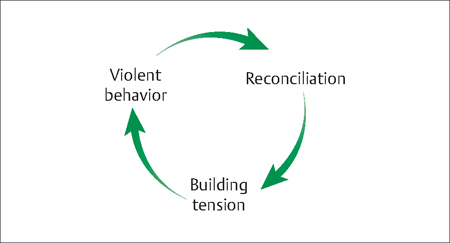53 Domestic Violence and Sexual Assault Robert L. Barbieri Domestic violence is defined as controlling or violent behavior by a person against an intimate partner. It necessarily involves at least two people: a perpetrator, and a victim. In some relationships a recurrent cycle of violence and reconciliation is observed (Fig. 53.1). Domestic violence is a breach of the human rights of the victim and destroys trust in the relationship. Domestic violence may include physical abuse, sexual assault, emotional abuse, social isolation, economic control, and even murder. Indirectly, children, adolescents, and other adults may be psychologically harmed by witnessing domestic violence in their home. Domestic violence represents a major health burden. It is difficult to detect without routine screening of at-risk populations. Routine screening is required to detect most cases of domestic violence. A single question has been demonstrated to increase the rate of detection: “At any time, has a partner hit, kicked, or otherwise hurt or threatened you?” A set of three questions that helps to detect domestic violence in pregnant women is: The screening for domestic violence must be performed in a private setting without the presence of anyone but the patient and clinician. A minority of patients initially object to being screened for domestic violence, but empathic support usually overcomes initial resistance to answer the question(s). Prefacing the direct question with a preamble, such as: “Violence is so common in our society, I ask all my patients about their exposure to violence” may help to overcome the resistance of some patients to responding to the question. An alternative to routine screening of all patients is to screen for domestic violence in patients known to be at increased risk: female emergency room patients and trauma victims, pregnant women, women with sexually transmitted diseases and women with chronic pain symptoms such as abdominal or pelvic pain, or headaches. Pediatricians have reported that detection and treatment of domestic violence may be the most effective means of preventing child abuse. Fig. 53.1 Three stages in a recurring cycle of domestic violence. Domestic violence is a worldwide problem. In large population surveys, about 5% of women reported at least one episode of domestic violence within the past year and about 25% reported a lifetime history of domestic violence. The Centers for Disease Control and Prevention (CDC) reports that domestic violence in the United States causes approximately 1200 deaths and 2 million injuries to women each year. Victims of domestic violence are more likely to smoke cigarettes, report risky sexual behaviors, and be disabled. They are also at increased risk for heart disease, stroke, asthma, and arthritis. The majority of women murdered by an intimate partner have had multiple contacts with the health care system in the year before their death. Approximately 10% of pregnant women are victims of domestic violence. Domestic violence may begin during a pregnancy or pregnancy may accelerate its intensity and frequency. Homicide is an important cause of death of pregnant women. Domestic violence during pregnancy may be associated with adverse pregnancy outcomes, including an increased risk of delivering a low birth weight infant. Factors that increase the risk of being a victim of domestic violence include poverty, low education level, unemployment, being unmarried, and having young children. Being a victim of domestic violence increases the risk of an afective disorder such as depression, and increases the risk of reporting symptoms including abdominal and pelvic pain. Domestic violence is common in heterosexual, gay, and lesbian relationships. In heterosexual relationships 95% of the victims are women. Children who experience domestic violence have an increased risk of afective disorders, aggression, and impulsivity. Children with a parent who is a victim of domestic violence may be at increased risk for obesity and diabetes when they become adults. Children can be protected against the adverse effects of domestic violence by experiencing supportive relationships inside and outside the home. Anger is a common human emotion. Many people are unable to manage their anger in socially acceptable forms, and when angry they behave violently against inanimate objects, animals, pets, and other people. Targeting an intimate partner is a complex expression of anger that often triggers a cycle of violence, followed by apologies and an interval of increased intimacy, followed by another episode of violence. Murder is an extreme manifestation of anger and violence in an intimate relationship. Women are more likely to be murdered by an intimate partner than all other types of assailants.
Domestic Violence
Definition
Detection

Prevalence and Epidemiology
Etiology
Treatment
Stay updated, free articles. Join our Telegram channel

Full access? Get Clinical Tree


